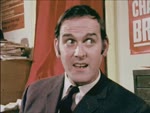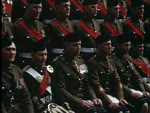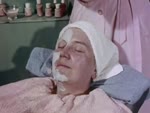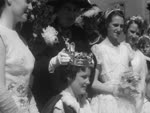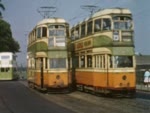MY HOME TOWN.....GLASGOW
Full length video
Please read Understanding catalogue records for help interpreting this information and Using footage for more information about accessing this film.
Title: MY HOME TOWN.....GLASGOW
Reference number: 8726
Date: 1968
Director: filmed by Sheila M Taylor
Sound: silent
Original format: std. 8mm
Colour: col
Fiction: Fiction
Running time: 47.38 mins
Description:
A boy writes a very detailed essay on the subject "My Home Town"; his words are illustrated by contemporary shots of Glasgow. Includes footage of the Cheapside Street fire.
Extensive donor's notes are held by Scottish Screen Archive.
Credits: Pupils of North Kelvinside School
Shotlist:
[Shotlisted from avi. file captured from speed corrected Digibeta]
FOCUS (.10) black (.15) The nature of this film required many splices for uneven running ..... we apologise but we make no apology for (.32) the RESEARCH TEAM [faces inset] (.37) the ELECTRICIANS [wearing masks] (.44) the PRODUCER the CAMERAMAN, the SCRIPTWRITER. WHO HAVE ALL GONE FISHING (.55) exts. North Kelvinside Public Pupils entering the classroom. Teacher writing on the blackboard setting the class an essay, entitled MY HOME TOWN. View of several children starting the write. (1.57) Once upon a time there were several hills ----------- Broomhill. Lambhill. Ruchill. Gilmorehill. Blythswoodhill. Camphill. Prospecthill. And a little river. The Clyde. The river was made bigger and deeper and on the hills the city grew. GLASGOW. (2.45) Boy pauses (2.50) Glasgow is a famous city. SONGS ARE SUNG ABOUT IT. (2.55) c/u record I belong to Glasgow - Will Fyffe. (3.01) Books are written about it. c/u Glasgow our city, Glasgow illustrated and No mean city (3.18) Boy turning round the look at what his classmates are doing. View of a bag with many different shields sewn on the front. (3.33) About 550AD a priest of the Celtic Church who was named MUNGO arrived in the little town of Cathures, later called GLASGOW. He built his church on the banks of the Molendinar burn which ran into the CLYDE. (3.53) Diagram of the burn following to the Clyde. (3.59) Mungo means "My dear friend". St Mungo became the patron Saint of Glasgow. (4.09) Shield of St Mungo. (4.13) St Mungo prayed over a dead robin and brought it back to life. When someone put out the fire from which the altar candles were lit ST Mungo relit it by praying over some twigs until they burst into flames. The bell is like the one that was rung during the services in the church of St Mungo. (4.38) View of a fish from the Shield. (4.42) The fish is a salmon with a ring in it's mouth as a remainder that salmon-fishing was the main industry when the town was a Bishop's seat. The original motto was "Let Glasgow Flourish by the Preaching of the Word and Praising thy Name" (4.58) Here's the bird that never flew. Here's the tree that never grew. Here's the bell that never rang. Here's the fish that never swam (5.07) c/u Shield of Glasgow (5.13) Glasgow Cathedral was built over the grave of St Mungo. (5.19) Ext. of Glasgow Cathedral (5.27) Today we can worship in many churches (5.30) c/u signs for the Scottish Episcopal Church, St Mary's Cathedral, Church of Jesus Christ of Latter-day Saints, Christian Science Church, Church of the Immaculate Conception and St George's - Tron Parish Church (6.05) View of the boy in class writing his essay (6.09) In 1492 the discovery of America made it obvious that Glasgow was ideally placed for a trading port (6.18) c/u map ship sailing across the Atlantic and to Glasgow (6.31) Many of our street names are remainders of old trading days (6.36) c/u paper is pulled away to show Jamaica, Glassford, and Tobago Street (6.48) c/u Two bags of sugar and tin of golden syrup (6.54) Washington and Virginia Street (6.59) Series of cigarette advertising boards (7.10) Boy in class writing (7.13) In 1662 Glasgow was a quiet town with four main street that were built in the shape of a cross (7.20) c/u map (7.27) The main streets were Gallowgate. Candleriggs. Rottenrow. Saltmarket (7.40) Today the City is 62 sq. miles in area (7.45) c/u maps (7.54) The main streets today are Argyle St, St Vincent St., Bath St., Sauchiehall St.; intercut views same (8.57) The population has increased (9.01) animated histogram of populations in 1700, 1800, 1900 & 1960 (9.11) The River Clyde had to be improved (9.17) c/u map showing the locations of docks and bridges (9.40) animated diagram showing bridges (10.06) c/u illustration of Glasgow Bridge 1820 (10.09) contemporary view of the bridge, busy with cars, vans and corporation buses (10.25) View over the bridges; c/u signs for the "Pedestrian Subway", Finnieston and Govan Vehicular Ferries (10.34) View of the ferries, tracking shot Clyde and dock cranes (10.53) c/u sign for the Clyde Tunnel; tracking shot through the Clyde Tunnel (11.46) MANY ROADS LEAD INTO THE CITY (11.50) c/u list; Edinburgh Rd., Bearsden Rd., Stirling Rd., Kilmarnock Rd., Dumbarton Rd., Great Western Rd (12.06) gv's same (12.41) GAIT is the old Scottish word meaning "way"... so now we have Bridgegate. Gallowgate. Drygate... (12.56) Illustration of Trongate in 1826. View of Trongate today (13.18) The first park was Glasgow Green, on which was field the Glasgow Fair for two weeks every July, as long ago as 800 years (13.27) c/u map of Glasgow parks today (13.37) tilt down signs forbidding football, cricket, littering and cycling (13.48) elevated shot Glasgow Green, partly covered with allotments? View of Kibble Palace. (14.25) BOTANIC GARDENS (14.29) elevated pan same (14.51) KELVINGROVE (14.56) gv's same, including view of Glasgow University main building and new Chemistry building (15.39) QUEENSPARK (15.43) gv's same (16.20) BELLAHOUSTON (16.26) gv's same (16.49) not forgetting HAMPDEN PARK (16.58) The first football club was formed in 1870, Queenspark - very soon we had several other clubs (17.06) Partick Thistle Rangers Clyde Celtic Third Lanark (17.13) c/u's boys wearing scarfs (17.24) In 1759 Gorbals was a little village - famous for making drums firearms, spinning-wheels, and cuckoo-clocks (17.37) today (17.40) gv's children at play in old streets and Hutchesontown high rise under construction in the Gorbals (18.49) In 1800 there were only 30 public wells to supply the people with water (18.56) c/u illustration of the Lady Well (19.03) NOW THERE ARE 1400 MILES OF WATER PIPE IN THE CITY (19.08) Boy in class writing; c/u of his bandaged finger (19.14) In 1476 the Hospital for the Poor was opened. St Nicholas Hospital (19.19) today (19.23) c/u stone plaque: "Glasgow Samaritan Hospital for Women"; ext hospital; Victoria Infirmary, patients lying out on balconies; c/u sign for Bon Secours Hospital, exts same; c/u sign for Western Infirmary Radiotherapy Dept., ext same; c/u sign for Glasgow Royal Infirmary (20.13) The Police Act 1800 was the start of (20.17) c/u van "City of Glasgow Police" (20.23) Gv's of policemen and police woman directing traffic, on horseback, on motorcycle, stopping to answer radio; red police call box (21.01) the first Hotel was opened in Gallowgate in 1755. Dr Johnson and Boswell stayed here in 1775 (21.10) nowadays (21.13) Sign for The Saracen Head and Saracens Head buildings, as small girl looks out from window above; c/u Illuminated hotel signs: Central Hotel. Grand Hotel Royal Hotel. More's Hotel. Bath Hotel (21.37) the first theatre built in Glasgow was in Queen Street, 1804 (21.43) to-day (21.45) c/u neon and illuminated signs for the Citzens theatre, Alhambra Theatre, Kings Theatre, Empire Theatre (21.56) In 1831 the first passenger train ran from Glasgow - the first station was QUEEN ST. (22.04) c/u signs for St Enoch's station. Central Station. British Railways Buchanan Street. Queen Street (22.20) The Tearoom originated here with MISS CRANSTON'S and Self-Service started in WILLIAM LANG'S (22.27) Boy eating a sandwich (22.34) c/u illuminated signs for various restaurants: one-o-one; Berkeley; Guys; Rogano Oyster Bar; Wendy's; Daniel Brown's; Royal; M & A Brown; Reids; Gordon Restaurant; A F Reid & Sons; The Marlborough; Fish Restaurant (23.11) the first picture-house opened in 1901 in Sauchiehall Street. (23.19) nowadays (23.20) Ext. of the Cosmo; La Scala; Regent and Odeon (23.30) Boy pauses to look at a foot tapping (23.38) c/u illuminated signs for Mecca Dancing Locarno; Majestic; Plaza; Albert; Barrowland (23.58) Boy looks around the classroom spots a chair (24.08) Glasgow was a Seat of Learning in 1451, when the University was opened (24.14) ext. of Glasgow University (25.01) To-day there are many colleges - (25.06) Ext of Strathclyde; c/u signs for Royal Academy of Music and College of Dramatic Art; Central College of Commerce; Glasgow Dental Hospital & School & Glasgow School of Art; exts. GSA; c/u sign Glasgow West of Scotland College of Domestic Science; exts. same (26.14) c/u one boy shakes his fist at the other (26.19) Ext of the Glasgow Friendly Society (26.28) Two boys fighting in the playground (26.36) Langside Battlefield memorial (26.58) c/u boy writing (26.59) FOCUS (27.08) Boy pausing to wipe his brow (27.13) The Grammar School of Glasgow opened in 1590 - lessons started at 5am ... now it is the HIGH SCHOOL for BOYS (27.24) exts. same (27.38) KELVINSIDE ACADEMY (27.41) exts. same (27.49) c/u sign "Newark Drive Nursery School"; Craigholme School; Hutchesons' Boys' Grammar School, pan of a new school building. c/u book, "The Glasgow Academy" (28.43) Park Westbourne St Aloysius ; Allan Glen's (28.49) Boy in class wiping his brow again (28.52) The average rainfall in Glasgow is 37.3" per annum (28.58) c/u pupils under umbrellas, rain nets, and a newspaper (29.10) Schweppes advert on the "Highland man's Umbrella", Central Station (29.20) c/u boy at desk, ms boy combing hair (29.24) Hely Julius PEDIANI (29.31) Ext of Gino hair stylists (29.35) c/u children writing in class (29.42) The first Chamber of Commerce in Britain was formed in Glasgow in 1782 - there are many shops in the city - (29.52) c/u signs: Saxone; Manfield and A L Scott & Son (30.04) c/u different shoes (30.19) c/u signs: McDonalds; Fraser Sons; Argyll Arcade; Hendersons; Watt Brothers; C&A; Wylie & Lochhead Ltd; John Smith & Co (Wools) Ltd; Trerons; Dalys; Reid & Todd; Muirheads and Pettigrew and Stephens (30.59) Sir Hugh Fraser owns most of them but the McIvers own The Barrows (31.08) gv's of the different stalls; The Shoe Corner and Sam McIver at the Barras; c/u shoppers and napping baby (30.02) c/u boy writing (32.09) Newspapers began to appear (32.14) c/u of two milk bottles on a door step with the Glasgow Herald, Evening Times, and Glasgow Weekly News newspapers. Child reading a comic book - Weird Planets (32.33) c/u boy looks at the electric light (32.39) XMAS ILLUMINATIONS 1962 (32.42) gv's Christmas street illuminations (33.33) c/u's girls and boy in class (33.41) The first underground cable railway in the World was opened by private enterprise and bought over, years later, by the Corporation (33.49) map of the subway route (33.57) The first tramline was laid in 1870 - the last tram ran in 1962 (34.02) View of no. 30 tram watched by crowds, exts. of Glasgow Corporation Transport building; gv's buses, brief shot young corporation staff (34.45) ext. of the Museum of Transport; c/u Glasgow fire engine (35.00) CHEAPSIDE MARCH 1960. 19 FIREMEN KILLED (35.05) gvs of the Cheapside fire, fireman on ladder silhouetted against fire (36.22) c/u boy; c/u knots and crosses (36.36) There are several Crosses in Glasgow (36.40) Shawlands Cross. View same. Gorbals Cross. View same. Bridgeton Cross. View same. Charing Cross. View same. St George's Cross. View same. Anniesland Cross. View of Anniesland cross; view same (38.28) there are some Squares, too - St Enoch's is named after St Thenaw, the mother of St Mungo (38.38) View of same. gv's George Square; pipe band playing at the war memorial, party lay a wreath; people sit on benches (39.34) Views of Royal Exchange Square, Blythswood Square, St Andrews Square (40.06) There are many places of cultural interest (40.10) c/u lealfet - The Old Glasgow Museum Guide (40.15) c/u sign for Art Gallery and Museum. ext. of Kelvingrove Museum (40.42) c/u leaflet for Dali's 'Christ of St John of the Cross'; c/u postcard of the painting; Kelvin Hall (41.04) ext. McLellan Galleries, c/u sign - The Glasgow Concert Hall ; Public Library - ext. of the Mitchell Library (41.35) There's plenty to do in the City (41.40) c/u of 'What's On' Guide May 1964 (41.46) Ext. of an ice rink. Sign for Kelvin Sports Arena. Greyhound racing at the White City Stadium ; Bingo (42.01) ms boy in front turns round to speak to the boy writing (42.08) Many changes are taking place - (42.11) C/u of three different styles of lamp post; demolition and building sites; No. 3? tram coming towards a red tram? stop; no. 59 bus coming down the same past bus stop (43.39) Boy writing in class (43.51) This is my hometown today (43.56) Gv's of the many different areas in Glasgow, including rag and bone man and c/u sign indicating new one way system, neon signs, busy roads and river (47.25) c/u boy (47.28) what will it look like tomorrow? (47.31) Boy finishes his essay to discover he is the last one left in the class. He leaves his jotter with the others and walks out the door. Boy runs home to look over Glasgow from the balcony of his flat at Wyndford flats; Gv's of Glasgow. The End. (47.38)


